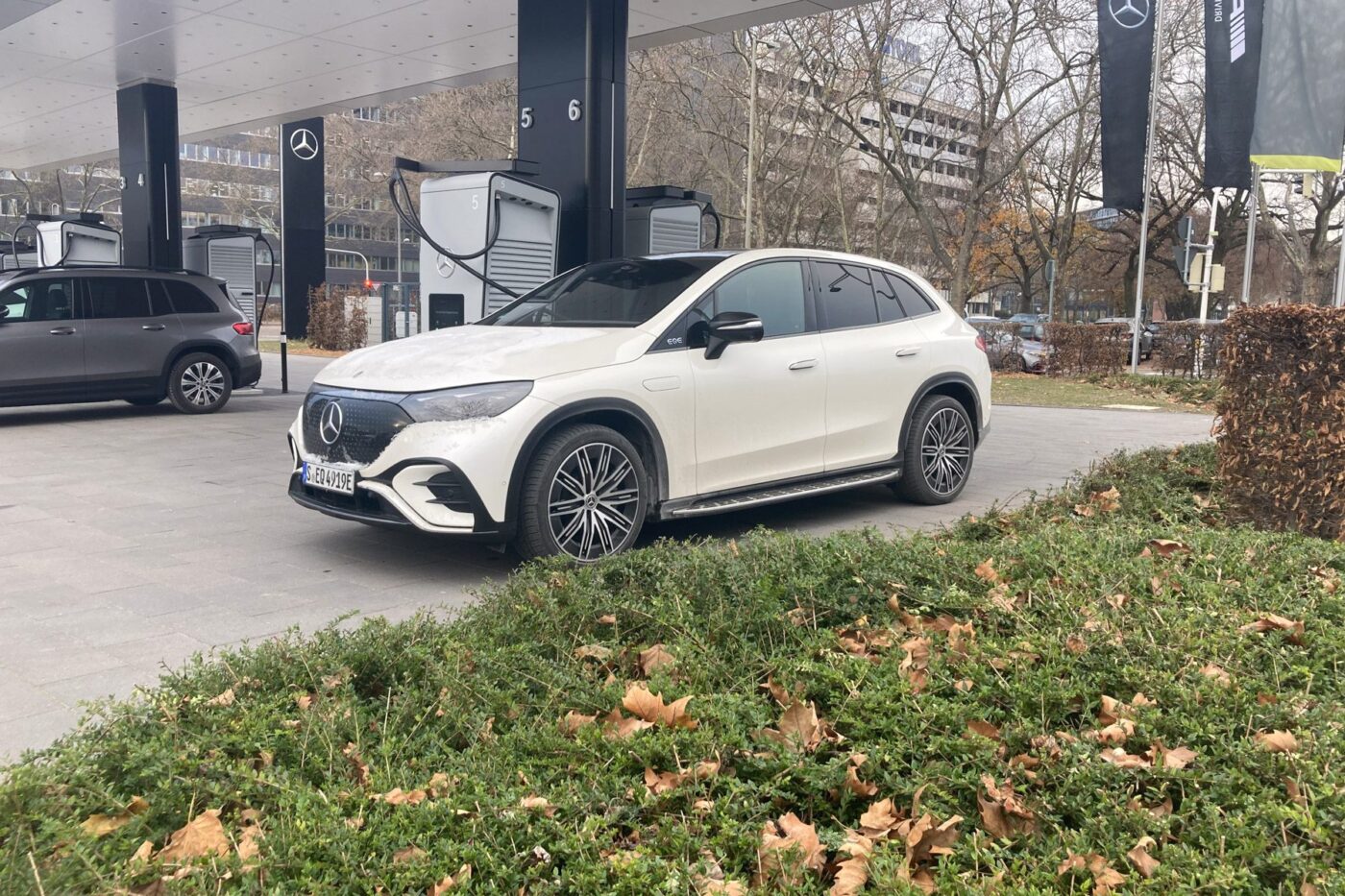
Testing the Mercedes EQE SUV in winter: There must be more to come
Mercedes’ promises for the electric future sound good. With the upcoming electric CLA – presented last year as the Concept CLA Class – Mercedes is offering an 800-volt system with short charging times, extended ranges and, on paper, low consumption of just 12 kWh per 100 kilometres. Thanks to silicon oxide in the anode, the battery’s energy density in the top-of-the-range version is set to increase, while LFP cells – rumoured to be from BYD – will be used in the base version.
But what is the current situation? We tested the EQE SUV 350 4MATIC in winter. The EQE saloon and the large EQS impressed us with their relatively low fuel consumption compared to the size of the vehicle, and thanks to the large batteries, they were also able to achieve decent practical ranges, we were in good spirits for the test of the EQE SUV. However, the conditions were not exactly EV friendly: the temperatures were sometimes just above and sometimes just below freezing point, and snowfall in some places increased rolling resistance.
These conditions were very noticeable in our test. Consumption of 28 to 30 kWh/100 kilometres was not uncommon, and on short journeys (not unusual in winter due to heating requirements), it was a few kilowatt-hours more. But our test car was not exactly economical on average either. Over the 10,216 kilometres on the onboard computer, the average – including summer journeys – was 26.3 kWh/100km. There is little left of the 553-kilometre WLTP range for this drive configuration.
Only 312 kilometres of test range
The EQE SUV 350 4MATIC has a battery with 90.56 kWh of usable energy content. With our winter motorway consumption of 29 kWh/100 km, it leaves only 312 kilometres – and if the usual long-distance window of ten to 80 per cent is taken into account, the range even drops to 218 kilometres. And even with the onboard computer average of 26.3 kWh/100 km, no more than 344 kilometres between charges are possible. Of course, it is impossible to precisely quantify how much of this is due to winter conditions or the shape of the bodywork. However, these figures are not outstanding for an electric car with a 90 kWh battery.
The same applies to fast charging. Here, the EQE SUV (as well as the saloon) offers a maximum charging capacity of 170 kW. The reason is simple. Compared to the 106 kWh battery from the EQS, Mercedes only installed ten instead of twelve battery modules in the smaller EQE but has left the interconnection of the modules the same. As a result, the EQE does not reach the 400-volt nominal voltage but only around 330 volts. The CCS standard is limited to a maximum charging current of 500 amps, so achieving the 200 kW charging capacity is impossible. Admittedly, at 32 minutes, the charging time from ten to 80 per cent is still within reasonable limits on paper. A BMW iX and the best-selling Tesla Model Y SUV, which is just under ten centimetres shorter, charge better at the lower end, while an Audi Q8 e-tron charges from around 50 per cent – all vehicles in the graph are charging curves measured by us, and the factory specification for the Audi is even higher.
In our test, we rarely achieved the ideal charging curve with the EQE SUV. Even with long preconditioning during an almost two-hour journey to the planned charging stop on the long haul, the 170 kW could not be reached. At peak, 142 kW was briefly displayed and those 32 minutes were needed to charge from 20 to 80 per cent. Incidentally, the system calculated another 26 minutes for the remaining 20 per cent.
There’s no question that going from 20 to 80 per cent in 32 minutes instead of the promised 10 to 80 per cent is not a massive loss of time; we have already tested electric cars with significantly greater problems at low temperatures. However, these were usually cheaper models. It is surprising that a Mercedes with a base price of just under 90,000 euros and a test car price well into six figures was unable to get the battery into the ideal temperature window after nearly two hours of driving. For one thing, the car had not cooled down overnight but had already been used extensively before this journey – including another quick charge earlier in the day. Secondly, the temperature was just below freezing point – deep winter conditions look different.
Charging planning is not convincing
However, the charging time didn’t necessarily make a negative impression during this charging process. We travelled from Düsseldorf to the Stuttgart area – on a Friday afternoon. When we set off at around 85 per cent, the system had planned a charging stop on the A3 at Ionity in Bad Camberg. Shortly before arriving, I saw in the Mercedes satellite navigation system that zero of the four charging points were available. But there was no warning. When I arrived at the service station, it quickly became clear that three other cars were already waiting for a free charging point. As I was a little more economical than the EQE SUV itself had planned (despite the consumption of almost 30 kWh/100 km), I still had nearly 30 per cent left in the battery. I could thus still reach the E.ON charging points at the next motorway service station. With some experience, briefly checking this in the relevant smartphone apps wasn’t a big problem. With a €100,000 electric car from a premium brand (which itself knew that all the charging points were occupied and that there was still more than enough power in the battery for the journey to the next fast charger), you can expect more by now. A small side note: for the remaining 214 kilometres to the destination, the Mercedes changed its mind several times about whether another short charging stop was necessary. Confidence is different.
Apart from the confusing charging planning, the EQE SUV did what you would expect of it on the motorway. It took the occupants to their destination comfortably and relaxed. The ride comfort is excellent despite the 21-inch tyres of the test car. The EQE SUV offers a supreme driving experience, provides clean suspension and rolls quietly – the interior remains pleasantly quiet even on the motorway. In this respect, travelling in the Benz is a real pleasure. It is not only the wheelbase of 3.03 metres that contributes to the stable directional stability, but also the rear axle steering. At higher speeds, this works in the same direction as the front axle’s steering, which extends the wheelbase further and makes the handling noticeably more stable.
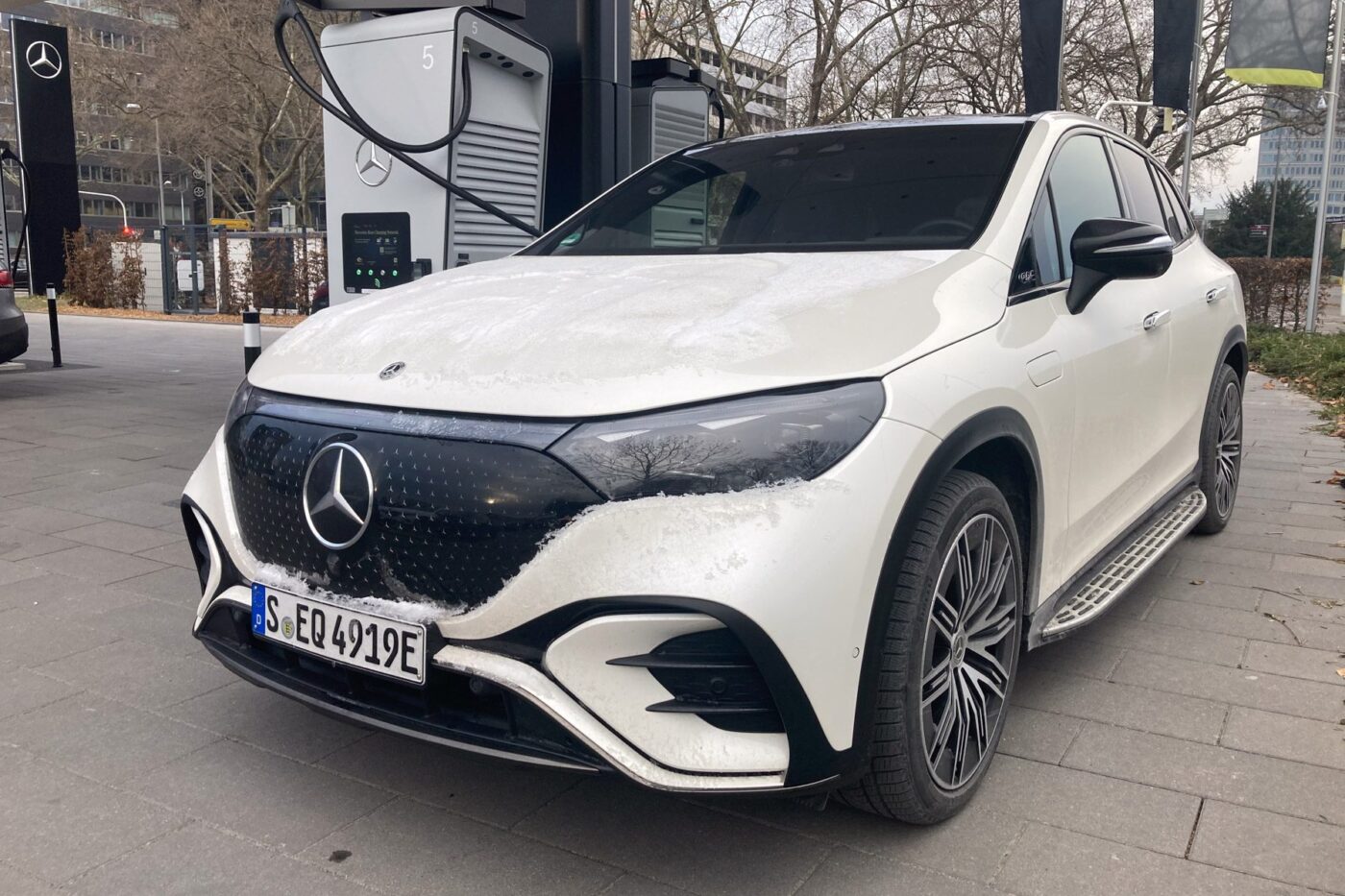
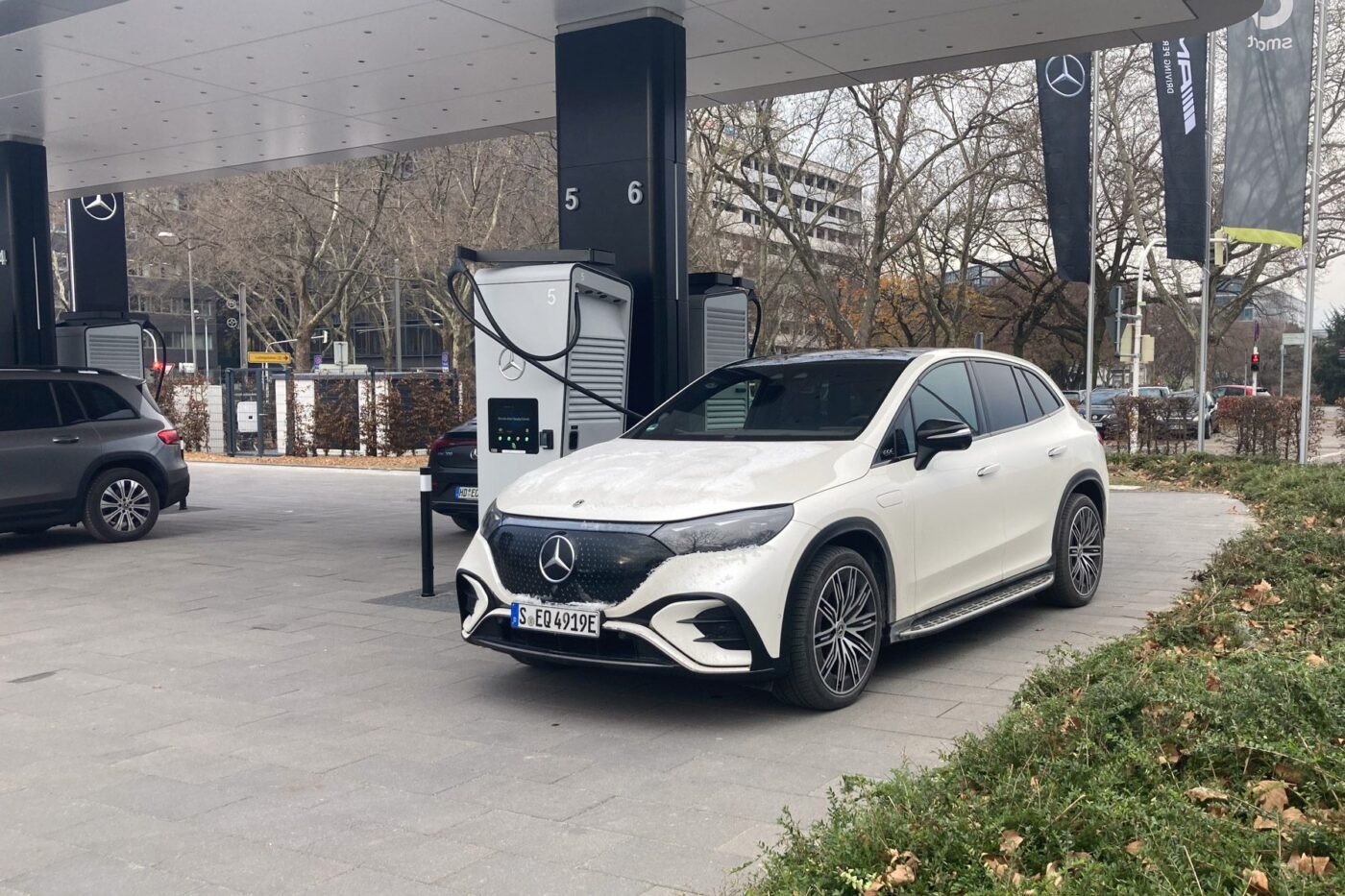
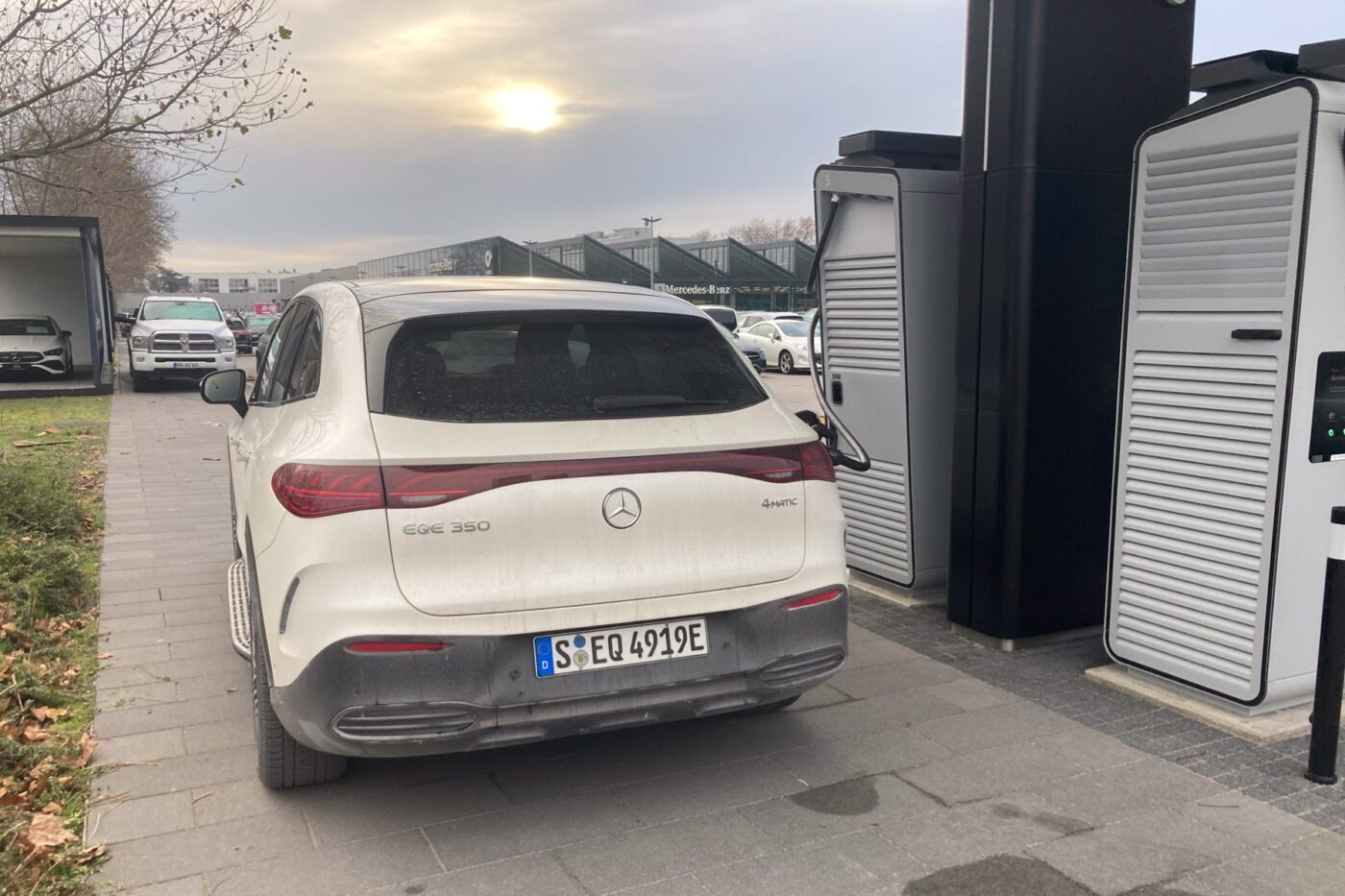
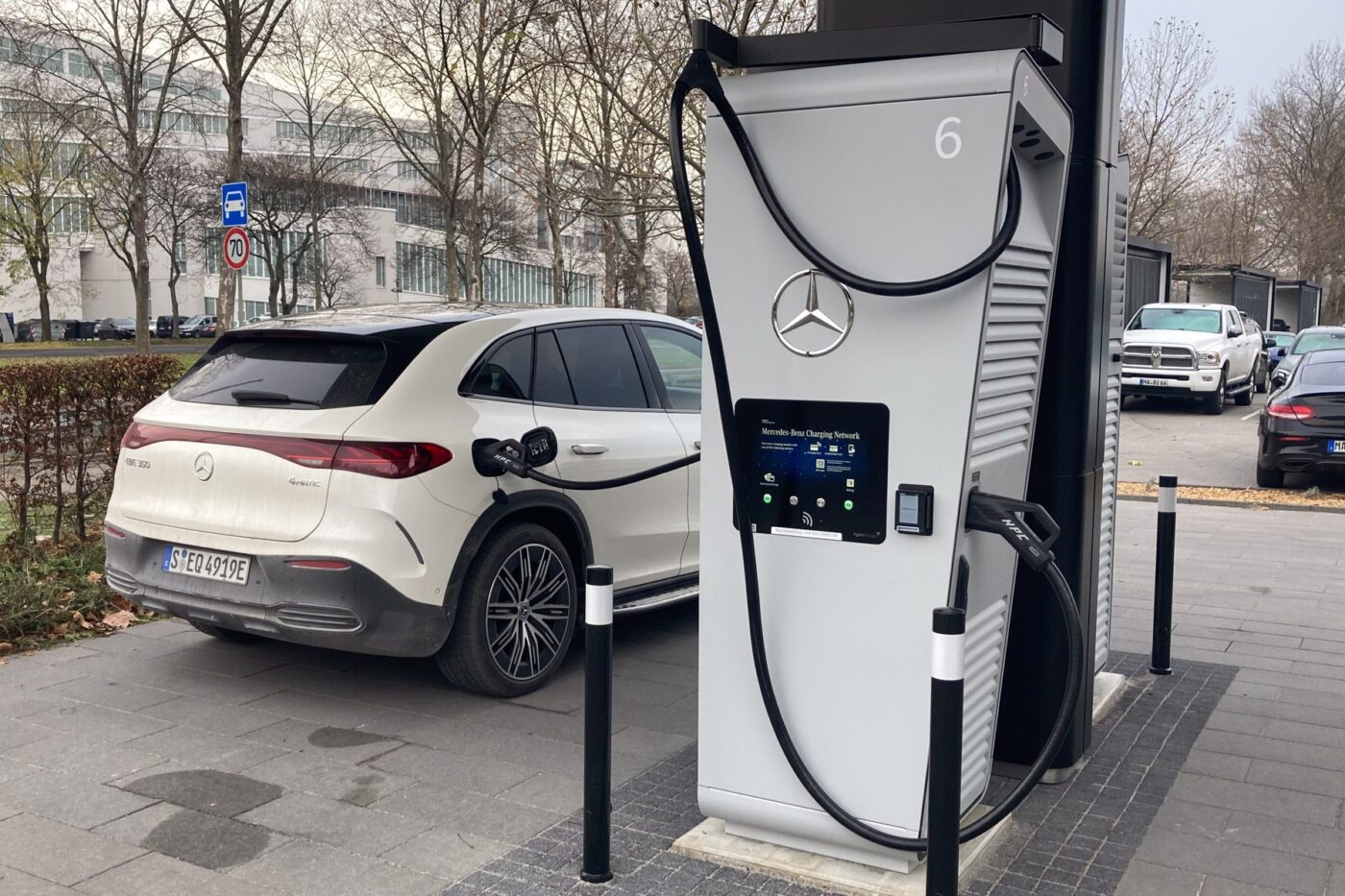
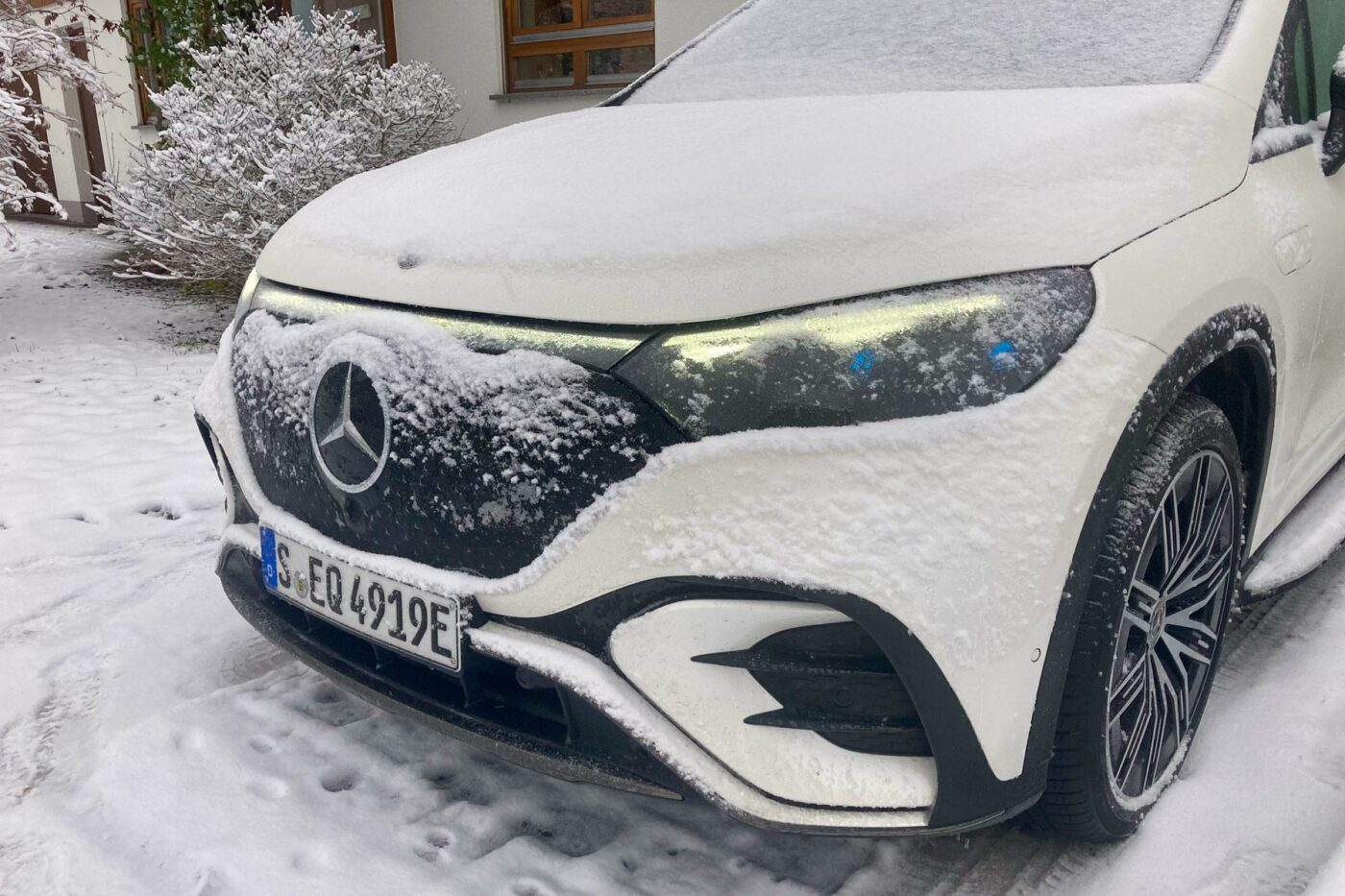
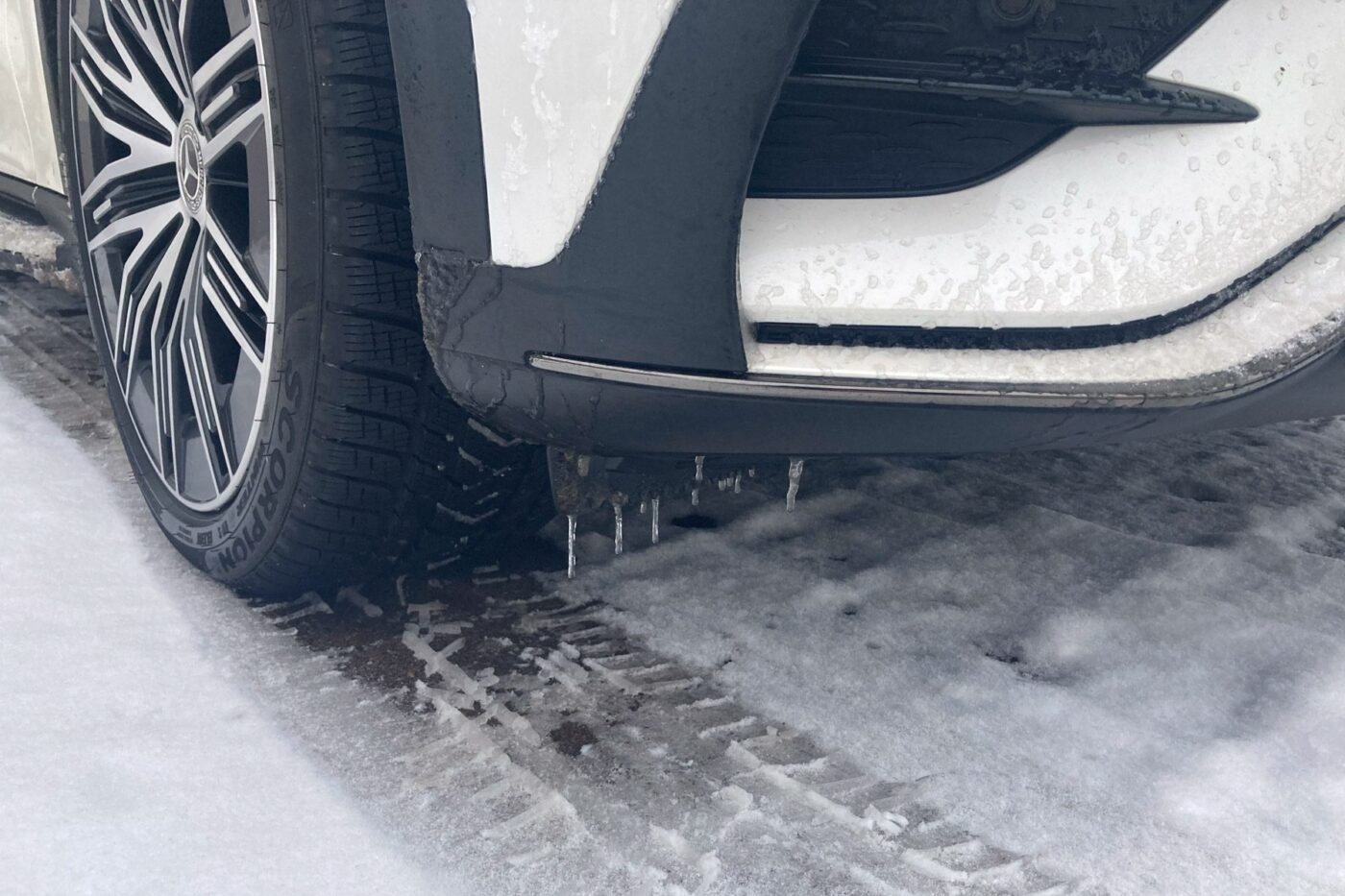
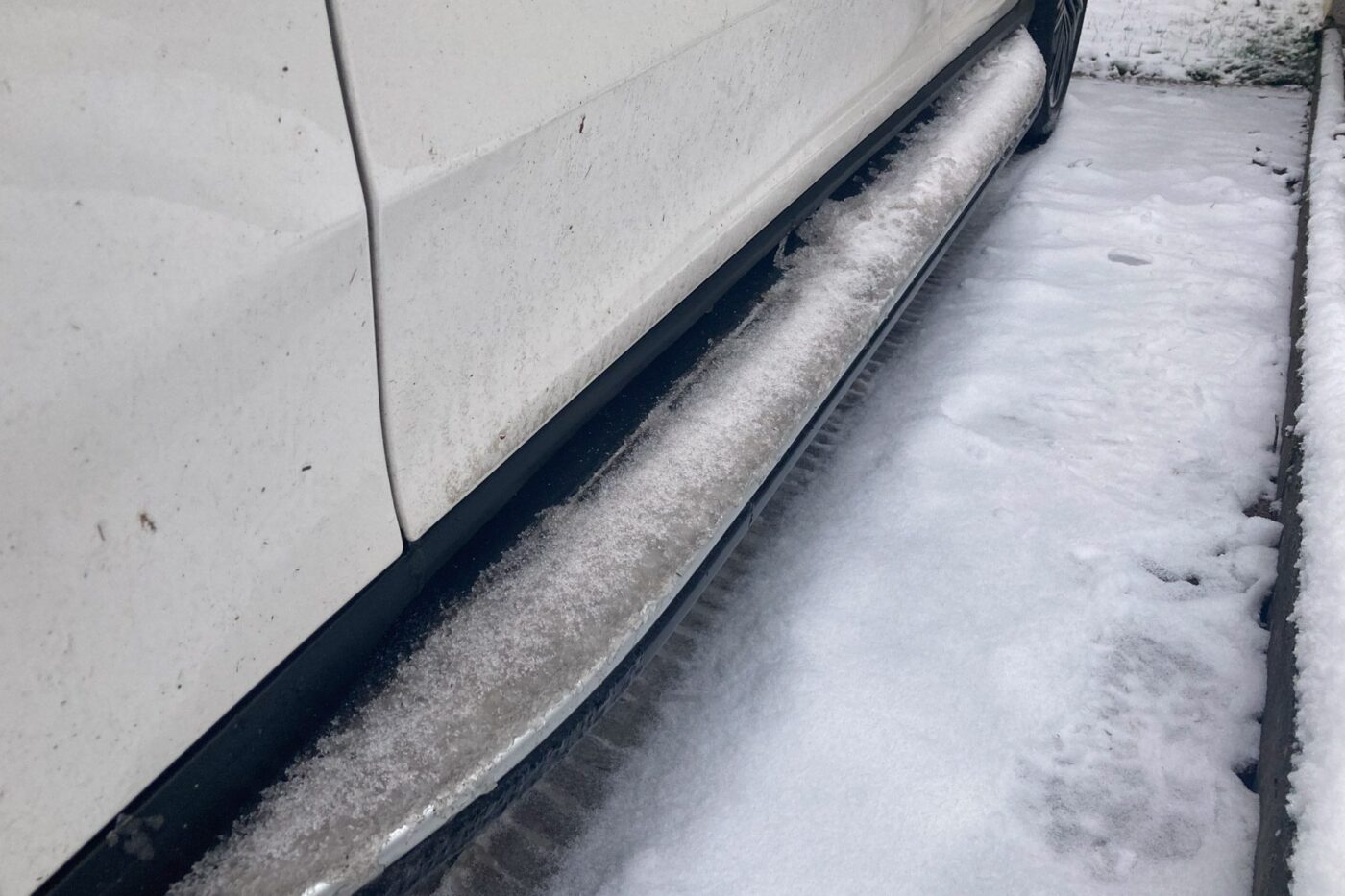
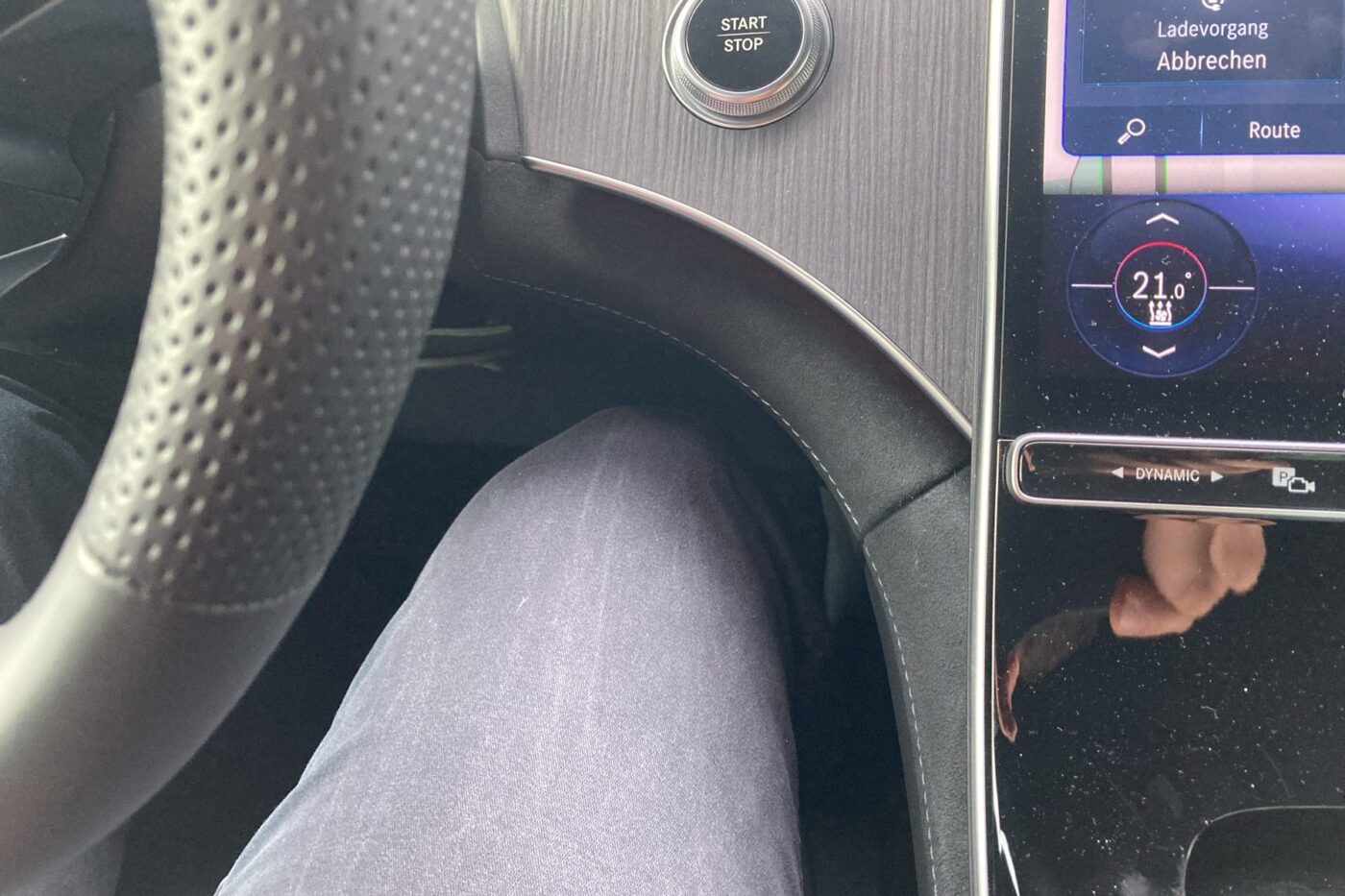
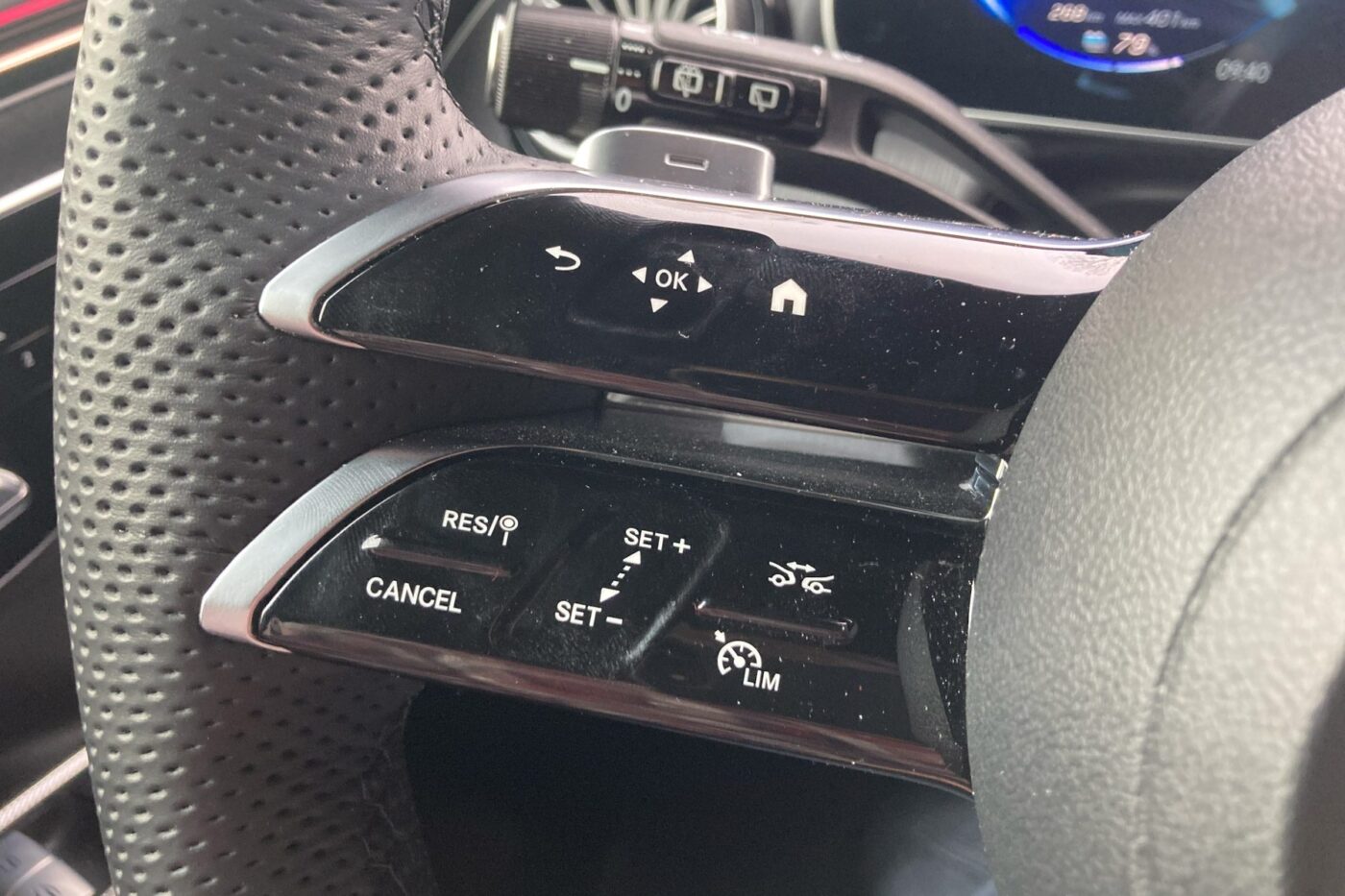
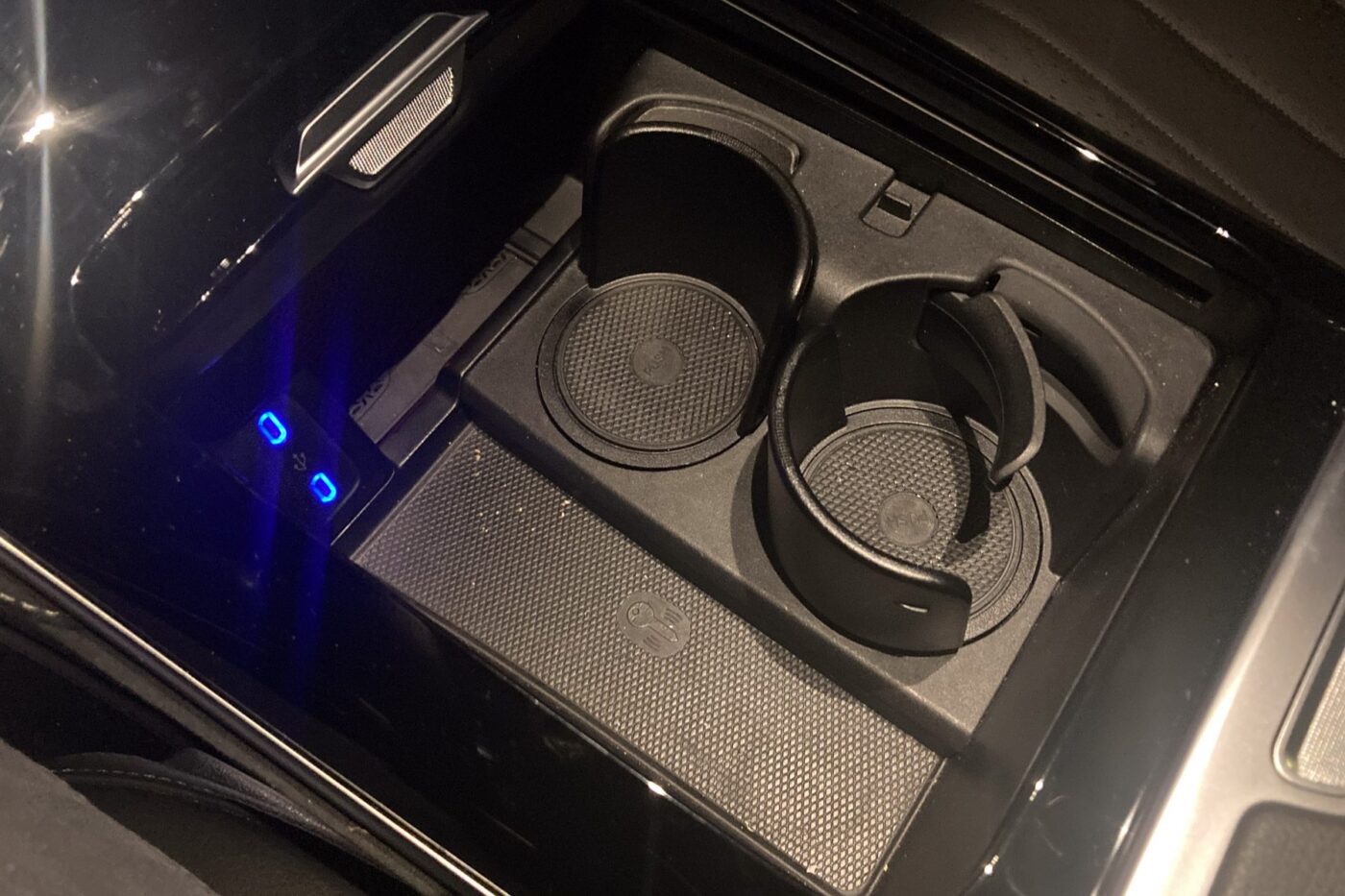
At low speeds, the rear axle steering works in the opposite direction. If the steering is turned to the right and the front wheels turn in this direction, the rear wheels are angled to the left – by a maximum of ten degrees. The result shortens the wheelbase; instead of a turning circle of 12.3 metres in the base model, this value is now only 10.5 metres with the optional extra. It doesn’t sound like much, but it makes a big difference, especially when manoeuvring in tight parking spaces or at the charging station. And we had to manoeuvre at some charging stations. As the charging port is not at one of the corners of the vehicle, but above the right rear wheel like a petrol cap, reaching it can get quite complicated. This is particularly bad with the widely used Hyperchargers from Alpitronic, should only the left charging space in front of the column be accessible. The ideal solution would be to reverse the EQE SUV into the right-hand parking space. However, if this is occupied, it depends on the length of the installed cable, whether you can plug it in relatively easily or whether you have to manoeuvre very precisely to get it just right. This, too, is not ideal for a 100,000 euro car.
A corresponding tuning of the drive accompanies the fundamentally superior driving impression. In the datasheet, 215 kW (or the equivalent of 292 hp) and 765 Nm of maximum torque sound like plenty of propulsion. However, the all-wheel drive is only slightly more vigorous in Sport mode; in the other modes, the accelerator pedal characteristics are not as dynamically tuned. The engines react more gently to the accelerator pedal. I find this different tuning very pleasant, depending on the driving mode. Still, some drivers also want slightly stronger acceleration in Comfort mode if the powertrain is technically capable of it.
The EQE SUV is not a space miracle
It remains a bit like the theme of the EQE SUV. With several aspects, a positive is followed by a “but.” In the interior, the materials used and the workmanship are impressive, (almost) everything looks very high-quality, and the ambient lighting all around creates a very pleasant lighting atmosphere. However, Mercedes has designed virtually the entire cockpit for the Hyperscreen, which is optional in the engine version of our test car. As a result, without the hyperscreen, a very high, bulky and useless surface is created in front of the front passenger. The dashboard is even higher than the window line at the top, and the protruding shape of the Hyperscreen, or, in our case, the wooden panel, restricts legroom at the bottom. Even as a driver, the steering column and knee were quite tight in my ideal seating position. In the saloons with a flatter seating position in relation to the dashboard, this was not a problem. For an SUV, it doesn’t feel like the ample space of a 4.86 metre-long premium model.
That also applies to the rear seat. A wheelbase of 3.03 metres and an all-electric platform with a theoretically flat floor promise good space for a vehicle of this size. In fact, it falls more into the “okay” category. That is also the case with the boot. 520 litres up to the parcel shelf are suitable for travelling, but with a vehicle length of 4.86 metres, they do not set a new standard. If the rear seat backrests are folded down, the EQE SUV can hold up to 1,675 litres. The Mercedes GLE combustion model is only six centimetres longer, but it is much more practical with a load volume of 630 to 2,055 litres. And the Audi Q8 e-tron also offers more than 600 litres. And while we’re on the subject of utility, the vehicle registration document for our test car with all-wheel drive stated a towing capacity of 1,800 kilograms.
A small detail about the interior: Mercedes has improved the cupholder in the centre console, which we criticised in the EQS 580 4MATIC in 2022. However, the basic design remains the same. You can use a large compartment in the centre console as a shelf or the rotating cup holders to hold your drinks. In the EQS, that was only possible with exactly matching bottles and cups. Mercedes has now added a small lever to the cup holder, which holds smaller bottles firmly in place thanks to a spring.
The optional running boards were also fitted to the outside of our test car. These serve as an entry aid and have an aerodynamic effect: the mouldings mounted on the sides under the doors calm the airflow along the rear of the vehicle and thus minimise air resistance, which should lead to a slightly higher range. However, in slush and snow, as was the case during our test drive, it is not always easy to get into the car without getting your pants dirty because you get caught on the running board.
When it comes to the software, it depends on personal habits as to whether the positive or the negative predominates. Apart from the weaknesses in charge planning, everything ran smoothly and without errors during the test. Mercedes leaves it up to its customers to decide whether they prefer the “zero layer” operation with a more straightforward home screen and buttons displayed by the system or a more classic menu navigation. Both worked, and anyone who has operated a Mercedes from a more recent model year will also quickly find their way around the EQE SUV. The range of apps in the MBUX for a little distraction during the charging break is growing but is still manageable overall.
Phantom braking also with Mercedes
In terms of driving assistance, the EQE SUV has the “intelligent traffic sign recognition” that is now mandatory for new models. We recently wrote about this in more detail in our test report on the Hyundai Ioniq 6. Mercedes has opted for a somewhat more relaxed interpretation of the EU regulation. The German carmaker does not issue a warning from the first kilometre per hour above the permitted speed limit, but only after a tolerance of three per cent. At 100 kph, the Mercedes only issues a warning from 103 kph, even with a speed-dependent delay. If you are only slightly above the trigger threshold, there is still a few seconds buffer in which the car only visually indicates that you are exceeding the limit. The driver thus has time to react and is not immediately beeped at. It works quite well – apart from the outdated speed limits stored in the map material – and meant that I usually left the assistant activated during the test period even though Mercedes has a much shorter way to deactivate it (button on the touchscreen) than Hyundai via the menu and the vehicle settings.
On the other hand, another assistant was not convincing: the collision warning system. During the two-week test, the system triggered three times and initiated emergency braking – jerky braking, the belt tensioners were activated and warned of a collision by flashing and beeping. Only there was no threat of a crash; each time the system was triggered, a vehicle in oncoming traffic driving a little closer to the centre line had triggered the system. After half a second, the computer also realised there would be no collision. You can imagine the shock of the occupants every time. The same applies here: this should not happen in a 100,000 euro Mercedes.
Conclusion
Although CEO Ola Källenius has given up on the 100 per cent electric target by 2030, he has not abandoned his luxury strategy. The EQE SUV is a decent car – but it was not so convincing in the test as to fully justify its (price) positioning at the upper end of the segment. Yes, the classic virtues such as ride comfort, materials and workmanship are all right. However, there is room for improvement in many other areas, from charging and space to software, which others are currently better at. Perhaps Mercedes will soon do this with the planned 800-volt changeover for the EVA II platform and the MMA for the upcoming CLA. Mercedes abandoned the advertising slogan “The best or nothing” some time ago. Looking at the EQE SUV, it has to be said: rightly so. Not because the car is terrible. But it’s not the best, either.
Translation by Carla Westerheide

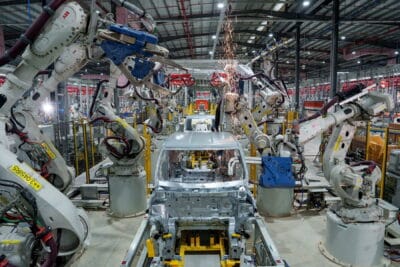
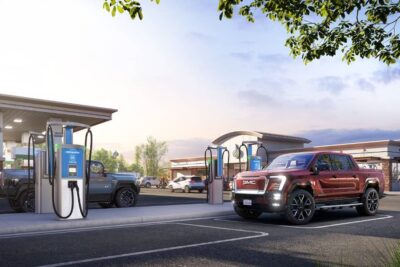
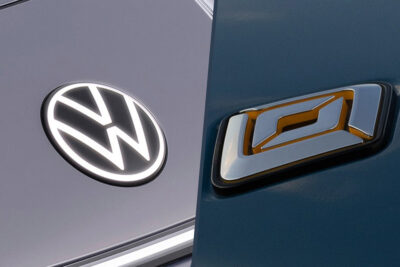
2 Comments